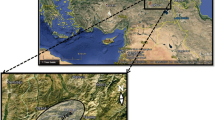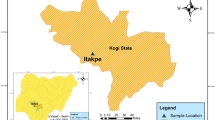Abstract
We compared the consistency of γ-ray spectrometry and inductively coupled plasma mass spectrometry by analyzing measurement results of the radioactive heat-producing elements U, Th, and K from borehole samples. This analysis was based on 49 samples obtained from mudstone, siltstone, and carbonate rock, and 11 of the 15 control groups showed great consistency. The radioactive heat production (RHP) of carbonate rocks was relatively low (0.23–0.63 µW m−3) and was mainly contributed by U. Mudstone and siltstone have higher RHPs, which was 1.73 ± 0.46 and 2.04 ± 0.49 µW m−3, respectively.






Similar content being viewed by others
References
Kramers JD, Kreissig K, Jones MQ (2001) Crustal heat production and style of metamorphism: a comparison between two Archean high grade provinces in the Limpopo Belt, southern Africa. Precambrian Res 112:149–163
He LJ, Hu SB, Yang WC, Wang JY (2009) Radiogenic heat production in the lithosphere of Sulu ultrahigh-pressure metamorphic belt. Earth Planet Sci Lett 277:525–538
Verdoya M, Pasquale V, Chiozzi P, Kukkonen IT (1998) Radiogenic heat production in the Variscan crust: new determinations and distribution models in Corsica (northwestern Mediterranean). Tectonophysics 291:63–75
Rudnick RL, McDonough WF, O’Connell RJ (1998) Thermal structure, thickness and composition of continental lithosphere. Chem Geol 145:395–411
Kumar PS, Reddy GK (2004) Radioelements and heat production of an exposed Archaean crustal cross-section, Dharwar craton, south India. Earth Planet Sci Lett 224:309–324
Kumar PS, Menon R, Reddy GK (2009) Heat production heterogeneity of the Indian crust beneath the Himalaya: insights from the northern Indian Shield. Earth Planet Sci Lett 283:190–196
Hasterok D, Chapman DS (2011) Heat production and geotherms for the continental lithosphere. Earth Planet Sci Lett 307:59–70
Yamaguchi TI, Yamano M, Nagao T, Goto S (2001) Distribution of radioactive heat production around an active fault and in accretionary prisms of southwest Japan. Phys Earth Planet In 126:269–277
Kumar PS, Menon R, Reddy GK (2007) The role of radiogenic heat production in the thermal evolution of a Proterozoic granulite-facies orogenic belt: Eastern Ghats, Indian Shield. Earth Planet Sci Lett 254:39–54
Artemieva IM, Mooney WD (2001) Thermal thickness and evolution of Precambrian lithosphere: a global study. J Geophys Res 106:16387–16414
Hasterok D, Chapman DS (2007) Continental thermal isostasy: 1. Methods and sensitivity. J Geophys Res 112:B06414
Brady RJ, Ducea MN, Kidder SB, Saleeby JB (2006) The distribution of radiogenic heat production as a function of depth in the Sierra Nevada Batholith, California. Lithos 86:229–244
Ketcham RA (1996) An improved method for determination of heat production with γ-ray scintillation spectrometry. Chem Geol 130:175–194
Chiozzi P, De Felice P, Fazio A, Pasquale V, Verdoya M (2000) Laboratory application of NaI (Tl) γ-ray spectrometry to studies of natural radioactivity in geophysics. Appl Radiat Isotopes 53:127–132
Tzortzis M, Tsertos H, Christofides S, Christodoulides G (2003) γ-ray measurements of naturally occurring radioactive samples from Cyprus characteristic geological rocks. Radiat Meas 37:221–229
Abbady AG, El-Arabi AM, Abbady A (2006) Heat production rate from radioactive elements in igneous and metamorphic rocks in Eastern Desert, Egypt. Appl Radiat Isotopes 64:131–137
Abbady A (2006) Radiological hazard and radiogenic heat production in some building materials in upper Egypt. J Radioanal Nucl Chem 268:243–246
Xhixha G, Bezzon GP, Broggini C, Buso GP, Caciolli A, Callegari I, Bianchi SD, Fiorentini G, Guastaldi E, Xhixha MK, Mantovani F, Massa G, Menegazzo R, Mou L, Pasquini A, Alvarez CR, Shyti M (2013) The worldwide NORM production and a fully automated γ-ray spectrometer for their characterization. J Radioanal Nucl Chem 295:445–457
Ibrahim N (1999) Natural activities of 238U, 232Th and 40 K in building materials. J Environ Radioact 43:255–258
Foster IDL, Boardman J, Keay-Bright J, Meadows ME (2005) Land degradation and sediment dynamics in the South African Karoo. Int Assoc Hydrol Sci Publ 292:207–213
Hamby DM, Tynybekov AK (2000) Uranium, thorium and potassium in soils along the shore of lake Issyk-Kyol in the Kyrghyz RepublicEnviron. Monit Assess 73:101–108
Fiorentini G, Lissia M, Mantovani F (2007) Geo-neutrinos and earth’s interior. Phys Rep 453:117–172
Enomoto S, Ohtani E, Inoue K, Suzuki A (2007) Neutrino geophysics with KamLAND and future prospects. Earth Planet Sc Lett 258:147–159
Dye S (2011) Geo-neutrinos as indicators of the origin and thermal history of the Earth. Rev Geophys 5(arXiv: 1111.6099), 0
Rybach L (1988) In: Hänel L, Rybach L, Stegena L (eds) Handbook of terrestrial heat flow density determination. Kluwer, Dordrecht
Xhixha M (2014) New γ-ray spectrometry methods for estimating K, U, Th concentrations in rocks of the Sardinia Batholith. University Of Sassari
Qiu NS (2003) Geothermal regime in the Qaidam basin, northeast Qinghai-Tibet Plateau. Geol Mag 140:707–719
Chiozzi P, Pasquale V, Verdoya M (2002) Naturally occurring radioactivity at the Alps-Apennines transition. Radiat Meas 35:147–154
Pasquale V, Verdoya M, Chiozzi P (2001) Radioactive heat generation and its thermal effects in the Alps-Apennines boundary zone. Tectonophysics 331:269–283
Abbady AG (2010) Evaluation of heat generation by radioactive decay of sedimentary rocks in Eastern Desert and Nile Valley, Egypt. Appl Radiat Isotopes 68:2020–2024
Čermák V, Haenel R (1982) Geothermics and geothermal energy. Schweizerbart Science Publishers, Schweizerbart
Čermák V (1982) Crustal temperature and mantle heat flow in Europe. Tectonophysics 83:123–142
Roque A, Ribeiro FB (1997) Radioactivity and radiogenic heat production in the sediments of the São Francisco sedimentary basin, Central Brazil. Appl Radiat Isotopes 48:413–422
Ribeiro FB, Roque A (2001) Vertical distributions of uranium, thorium and potassium and of volumetric heat production rates in the sediments of the São Francisco basin, Central Brazil. Appl Radiat Isotopes 55:393–405
Vilà M, Fernández M, Jiménez-Munt I (2010) Radiogenic heat production variability of some common lithological groups and its significance to lithospheric thermal modeling. Tectonophysics 490:152–164
Murthy VR, Van Westrenen W, Fei Y (2003) Experimental evidence that potassium is a substantial radioactive heat source in planetary cores. Nature 423:163–165
Acknowledgements
The study was supported by the National Science Foundation of China (Grant No. 41690133, 41772248), the “National Science and Technology Major Project” of China (Grant No. 2017ZX05008004) and the Beijing Training Project of Science and Technology Nova and Leading Talent (Grant No. Z171100001117163). The first author is grateful to the Chinese Scholarship Council (CSC) for supporting him stay in the University of Glasgow as a sponsored researcher. We thank Dr. Bing Xu and Mu Liu for their help in the sample analysis and the reviewers for their constructive suggestions, which clarified many points of this article.
Author information
Authors and Affiliations
Corresponding author
Rights and permissions
About this article
Cite this article
Zhu, C., Xu, M., Qiu, N. et al. Comparison of γ-ray spectrometry and ICP-MS methods for measuring radioactive heat-producing elements of rocks: a case study on borehole samples from the Sichuan Basin, China. J Radioanal Nucl Chem 314, 1527–1537 (2017). https://doi.org/10.1007/s10967-017-5576-4
Received:
Published:
Issue Date:
DOI: https://doi.org/10.1007/s10967-017-5576-4




